�
10 Craziest animal behavior
Published on 6/5/2006
Squids: have sex all day long, for two weeks
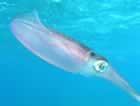 Squids are a large, diverse group of marine cephalopods. They begin mating with a circling
nuptial dance, revolving around across a `spawning bed' (200 metres, in diameter). At daybreak,
they begin having sex and continue all day long --they only take a break so the female
can drive down and deposit eggs. When she returns to the circle, the two go at it again. As
twilight falls, the pair go offshore to eat and rest. At the first sign of sunlight, they
return to their spot and do it all over again.
Squids are a large, diverse group of marine cephalopods. They begin mating with a circling
nuptial dance, revolving around across a `spawning bed' (200 metres, in diameter). At daybreak,
they begin having sex and continue all day long --they only take a break so the female
can drive down and deposit eggs. When she returns to the circle, the two go at it again. As
twilight falls, the pair go offshore to eat and rest. At the first sign of sunlight, they
return to their spot and do it all over again.
Adele Penguin: conquers his mate by rolling a stone at her feets
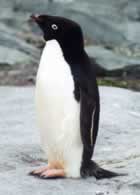 Penguins in general prefer to be `married', but they suffer long separations due to their
migratory habits. When reunited, a pair will stand breast to breast, heads thrown back, singing
loudly, with outstretched flippers trembling. Two weeks after a pair is formed, their union is
consummated. The male makes his intentions known by laying his head across his partner's
stomach. They go on a long trek to find privacy, but the actual process of intercourse takes
only three minutes. Neither penguin will mate again that year.
The male Adele penguin must select his mate from a colony of more than a million, and he
indicates his choice by rolling a stone at the female's feet. Stones are scarce at mating time
because many are needed to build walls around nests. It becomes commonplace for penguins to
steal them from one another. If she accepts this gift, they stand belly to belly and sing a
mating song.
Penguins in general prefer to be `married', but they suffer long separations due to their
migratory habits. When reunited, a pair will stand breast to breast, heads thrown back, singing
loudly, with outstretched flippers trembling. Two weeks after a pair is formed, their union is
consummated. The male makes his intentions known by laying his head across his partner's
stomach. They go on a long trek to find privacy, but the actual process of intercourse takes
only three minutes. Neither penguin will mate again that year.
The male Adele penguin must select his mate from a colony of more than a million, and he
indicates his choice by rolling a stone at the female's feet. Stones are scarce at mating time
because many are needed to build walls around nests. It becomes commonplace for penguins to
steal them from one another. If she accepts this gift, they stand belly to belly and sing a
mating song.
Ferrets: dance when excited
 When ferrets are especially excited, they will perform the weasel war dance, a frenzied series
of sideways hops. This is often accompanied by an arched back, dooking or hissing noises, or a
frizzy tail. The war dance usually follows play or the successful capture of a toy or a stolen
object. Although the weasel war dance may make a ferret appear frightened or angry, they are
often just excited and are usually harmless to humans.
When ferrets are especially excited, they will perform the weasel war dance, a frenzied series
of sideways hops. This is often accompanied by an arched back, dooking or hissing noises, or a
frizzy tail. The war dance usually follows play or the successful capture of a toy or a stolen
object. Although the weasel war dance may make a ferret appear frightened or angry, they are
often just excited and are usually harmless to humans.
Ichneumon wasps: tortures other insects
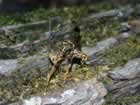 Ichneumon wasps are insects that could inspire a horror movie: it picks a victim, usually a
caterpillar, and injects her eggs into the host's body. Often she also injects a poison that
paralyzes the victim without killing it. Then, it eats the caterpillar but it keeps the
victim alive as long as possible by eating its fatty deposits and digestive organs first
and saving the heart and central nervous system for last.
Charles Darwin found the grisly life histories of Ichneumons incompatible with the
central notion of natural theology which saw the study of nature as a way to demonstrate God's
benevolence. In a letter to American botanist Asa Gray, Darwin wrote "I cannot persuade myself
that a beneficent and omnipotent God would have designedly created the Ichneumonidae with the
express intention of their feeding within the living bodies of Caterpillars, or that a cat
should play with mice."
Ichneumon wasps are insects that could inspire a horror movie: it picks a victim, usually a
caterpillar, and injects her eggs into the host's body. Often she also injects a poison that
paralyzes the victim without killing it. Then, it eats the caterpillar but it keeps the
victim alive as long as possible by eating its fatty deposits and digestive organs first
and saving the heart and central nervous system for last.
Charles Darwin found the grisly life histories of Ichneumons incompatible with the
central notion of natural theology which saw the study of nature as a way to demonstrate God's
benevolence. In a letter to American botanist Asa Gray, Darwin wrote "I cannot persuade myself
that a beneficent and omnipotent God would have designedly created the Ichneumonidae with the
express intention of their feeding within the living bodies of Caterpillars, or that a cat
should play with mice."
Porcupines: how do they do it?
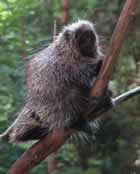 There is a common joke: "How do porcupines do it?" "Very carefully." But in reality, the truth
is more bizarre than dangerous. Females are only receptive for a few hours a yearm, so they go
off their food, and stick close by the males and mope. Meanwhile the male becomes aggressive
with other males, and begins a period of carefully sniffing every place the female of his
choice urinates, smelling her all over. This is a tremendous aphrodisiac. While she is
sulking by his side, he begins to `sing'.
When he is ready to make love, the female runs away if she's not ready. If she is in the mood,
they both rear up and face each other, belly-to-belly. Then, males spray their ladies with a
tremendous stream of urine, soaking their loved one from head to foot - the stream can shoot as
far as 7 feet. It is advised never to stand close to a cage that contains courting porcupines.
There is a common joke: "How do porcupines do it?" "Very carefully." But in reality, the truth
is more bizarre than dangerous. Females are only receptive for a few hours a yearm, so they go
off their food, and stick close by the males and mope. Meanwhile the male becomes aggressive
with other males, and begins a period of carefully sniffing every place the female of his
choice urinates, smelling her all over. This is a tremendous aphrodisiac. While she is
sulking by his side, he begins to `sing'.
When he is ready to make love, the female runs away if she's not ready. If she is in the mood,
they both rear up and face each other, belly-to-belly. Then, males spray their ladies with a
tremendous stream of urine, soaking their loved one from head to foot - the stream can shoot as
far as 7 feet. It is advised never to stand close to a cage that contains courting porcupines.
Gastric-brooding frogs: swallows her own eggs
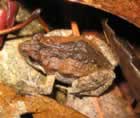 The female gastric-brooding frogs are a genus, Rheobatrachus, of frogs from East Australia. The
curiosity with these frogs is their unique parental care: following external fertilisation by
the male, the female would take the eggs into its mouth and swallow them. It is not clear,
however, whether the females swallowed the tadpoles or the eggs, as it was never observed prior
to their extinction. The last captive specimen died in 1984.
The female gastric-brooding frogs are a genus, Rheobatrachus, of frogs from East Australia. The
curiosity with these frogs is their unique parental care: following external fertilisation by
the male, the female would take the eggs into its mouth and swallow them. It is not clear,
however, whether the females swallowed the tadpoles or the eggs, as it was never observed prior
to their extinction. The last captive specimen died in 1984.
Red-sided Garter Snakes: they prefer orgies
 These snakes are small and poisonous, and live in Canada and the Northwestern United States.
Their highly unusual mating takes place during an enormous orgy. Twenty-five thousand snakes
slither together in a large den, eager to copulate. In that pile, one female may have as
many as 100 males vying for her. These `nesting balls' grow as large as two feet high. Now and
then a female is crushed under the heavy mound - and the males are so randy that they continue
to copulate, becoming the only necrophiliac snakes!
These snakes are small and poisonous, and live in Canada and the Northwestern United States.
Their highly unusual mating takes place during an enormous orgy. Twenty-five thousand snakes
slither together in a large den, eager to copulate. In that pile, one female may have as
many as 100 males vying for her. These `nesting balls' grow as large as two feet high. Now and
then a female is crushed under the heavy mound - and the males are so randy that they continue
to copulate, becoming the only necrophiliac snakes!
Hippos: attracts mates by urinating and defecating
 Hippos have their own form of aromatherapy. Hippos attract mates by marking territory,
urinating and defecating at the same time. Then, an enamored hippo will twirl its tail
like a propellor to spread this delicious slop in every direction. This attracts lovers, and a
pair will begin foreplay, which consists of playing by splashing around in the water before
settling down to business.
Hippos have their own form of aromatherapy. Hippos attract mates by marking territory,
urinating and defecating at the same time. Then, an enamored hippo will twirl its tail
like a propellor to spread this delicious slop in every direction. This attracts lovers, and a
pair will begin foreplay, which consists of playing by splashing around in the water before
settling down to business.
Male Anglerfishes: smell his mate and never leaves her again
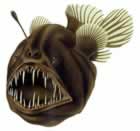 Anglerfishes are bony fishes. Some of them have a unique mating method: Since individuals are
rare and encounters doubly so, finding a mate is a problem, especially at a time when both
individuals are ready to spawn.
When a male anglerfish hatches, it is equipped with extremely well developed olfactory organs
that detect scents in the water. They have no digestive system, and thus are unable to feed
independently. They must find a female anglerfish, and quickly, or else they will die.
When he finds a female, he bites into her flank, and releases an enzyme which digests the skin
of his mouth and her body, fusing the pair down to the blood vessel level. The male then
atrophies into nothing more than a pair of gonads that release sperm in response to hormones in
the female's bloodstream indicating egg release. This is an extreme example of sexual
dimorphism. However, it ensures that when the female is ready to spawn, she has a mate
immediately available.
Anglerfishes are bony fishes. Some of them have a unique mating method: Since individuals are
rare and encounters doubly so, finding a mate is a problem, especially at a time when both
individuals are ready to spawn.
When a male anglerfish hatches, it is equipped with extremely well developed olfactory organs
that detect scents in the water. They have no digestive system, and thus are unable to feed
independently. They must find a female anglerfish, and quickly, or else they will die.
When he finds a female, he bites into her flank, and releases an enzyme which digests the skin
of his mouth and her body, fusing the pair down to the blood vessel level. The male then
atrophies into nothing more than a pair of gonads that release sperm in response to hormones in
the female's bloodstream indicating egg release. This is an extreme example of sexual
dimorphism. However, it ensures that when the female is ready to spawn, she has a mate
immediately available.
Histiostoma murchiei: creates her own husband
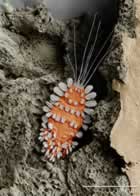 The female mite known as Histiostoma murchiei creates her own husband from scratch. She lays
eggs that turn into adults without needing to be fertilised. The mother then copulates with her
sons within three of four days of laying the eggs, after which the sons die rather quickly.
The female mite known as Histiostoma murchiei creates her own husband from scratch. She lays
eggs that turn into adults without needing to be fertilised. The mother then copulates with her
sons within three of four days of laying the eggs, after which the sons die rather quickly.
Submit to:
 Del.icio.us Del.icio.us
 Netscape Netscape
 Furl Furl
 Facebook Facebook
 |
|
|
|
|
|
 Send by Email Send by Email
|
�
|


 Del.icio.us
Del.icio.us
 Netscape
Netscape
 Furl
Furl
 Facebook
Facebook
 Squids are a large, diverse group of marine cephalopods. They begin mating with a circling
nuptial dance, revolving around across a `spawning bed' (200 metres, in diameter). At daybreak,
they begin having sex and continue all day long --they only take a break so the female
can drive down and deposit eggs. When she returns to the circle, the two go at it again. As
twilight falls, the pair go offshore to eat and rest. At the first sign of sunlight, they
return to their spot and do it all over again.
Squids are a large, diverse group of marine cephalopods. They begin mating with a circling
nuptial dance, revolving around across a `spawning bed' (200 metres, in diameter). At daybreak,
they begin having sex and continue all day long --they only take a break so the female
can drive down and deposit eggs. When she returns to the circle, the two go at it again. As
twilight falls, the pair go offshore to eat and rest. At the first sign of sunlight, they
return to their spot and do it all over again.
 Penguins in general prefer to be `married', but they suffer long separations due to their
migratory habits. When reunited, a pair will stand breast to breast, heads thrown back, singing
loudly, with outstretched flippers trembling. Two weeks after a pair is formed, their union is
consummated. The male makes his intentions known by laying his head across his partner's
stomach. They go on a long trek to find privacy, but the actual process of intercourse takes
only three minutes. Neither penguin will mate again that year.
The male Adele penguin must select his mate from a colony of more than a million, and he
indicates his choice by rolling a stone at the female's feet. Stones are scarce at mating time
because many are needed to build walls around nests. It becomes commonplace for penguins to
steal them from one another. If she accepts this gift, they stand belly to belly and sing a
mating song.
Penguins in general prefer to be `married', but they suffer long separations due to their
migratory habits. When reunited, a pair will stand breast to breast, heads thrown back, singing
loudly, with outstretched flippers trembling. Two weeks after a pair is formed, their union is
consummated. The male makes his intentions known by laying his head across his partner's
stomach. They go on a long trek to find privacy, but the actual process of intercourse takes
only three minutes. Neither penguin will mate again that year.
The male Adele penguin must select his mate from a colony of more than a million, and he
indicates his choice by rolling a stone at the female's feet. Stones are scarce at mating time
because many are needed to build walls around nests. It becomes commonplace for penguins to
steal them from one another. If she accepts this gift, they stand belly to belly and sing a
mating song.
 When ferrets are especially excited, they will perform the weasel war dance, a frenzied series
of sideways hops. This is often accompanied by an arched back, dooking or hissing noises, or a
frizzy tail. The war dance usually follows play or the successful capture of a toy or a stolen
object. Although the weasel war dance may make a ferret appear frightened or angry, they are
often just excited and are usually harmless to humans.
When ferrets are especially excited, they will perform the weasel war dance, a frenzied series
of sideways hops. This is often accompanied by an arched back, dooking or hissing noises, or a
frizzy tail. The war dance usually follows play or the successful capture of a toy or a stolen
object. Although the weasel war dance may make a ferret appear frightened or angry, they are
often just excited and are usually harmless to humans.
 Ichneumon wasps are insects that could inspire a horror movie: it picks a victim, usually a
caterpillar, and injects her eggs into the host's body. Often she also injects a poison that
paralyzes the victim without killing it. Then, it eats the caterpillar but it keeps the
victim alive as long as possible by eating its fatty deposits and digestive organs first
and saving the heart and central nervous system for last.
Charles Darwin found the grisly life histories of Ichneumons incompatible with the
central notion of natural theology which saw the study of nature as a way to demonstrate God's
benevolence. In a letter to American botanist Asa Gray, Darwin wrote "I cannot persuade myself
that a beneficent and omnipotent God would have designedly created the Ichneumonidae with the
express intention of their feeding within the living bodies of Caterpillars, or that a cat
should play with mice."
Ichneumon wasps are insects that could inspire a horror movie: it picks a victim, usually a
caterpillar, and injects her eggs into the host's body. Often she also injects a poison that
paralyzes the victim without killing it. Then, it eats the caterpillar but it keeps the
victim alive as long as possible by eating its fatty deposits and digestive organs first
and saving the heart and central nervous system for last.
Charles Darwin found the grisly life histories of Ichneumons incompatible with the
central notion of natural theology which saw the study of nature as a way to demonstrate God's
benevolence. In a letter to American botanist Asa Gray, Darwin wrote "I cannot persuade myself
that a beneficent and omnipotent God would have designedly created the Ichneumonidae with the
express intention of their feeding within the living bodies of Caterpillars, or that a cat
should play with mice."
 There is a common joke: "How do porcupines do it?" "Very carefully." But in reality, the truth
is more bizarre than dangerous. Females are only receptive for a few hours a yearm, so they go
off their food, and stick close by the males and mope. Meanwhile the male becomes aggressive
with other males, and begins a period of carefully sniffing every place the female of his
choice urinates, smelling her all over. This is a tremendous aphrodisiac. While she is
sulking by his side, he begins to `sing'.
When he is ready to make love, the female runs away if she's not ready. If she is in the mood,
they both rear up and face each other, belly-to-belly. Then, males spray their ladies with a
tremendous stream of urine, soaking their loved one from head to foot - the stream can shoot as
far as 7 feet. It is advised never to stand close to a cage that contains courting porcupines.
There is a common joke: "How do porcupines do it?" "Very carefully." But in reality, the truth
is more bizarre than dangerous. Females are only receptive for a few hours a yearm, so they go
off their food, and stick close by the males and mope. Meanwhile the male becomes aggressive
with other males, and begins a period of carefully sniffing every place the female of his
choice urinates, smelling her all over. This is a tremendous aphrodisiac. While she is
sulking by his side, he begins to `sing'.
When he is ready to make love, the female runs away if she's not ready. If she is in the mood,
they both rear up and face each other, belly-to-belly. Then, males spray their ladies with a
tremendous stream of urine, soaking their loved one from head to foot - the stream can shoot as
far as 7 feet. It is advised never to stand close to a cage that contains courting porcupines.
 The female gastric-brooding frogs are a genus, Rheobatrachus, of frogs from East Australia. The
curiosity with these frogs is their unique parental care: following external fertilisation by
the male, the female would take the eggs into its mouth and swallow them. It is not clear,
however, whether the females swallowed the tadpoles or the eggs, as it was never observed prior
to their extinction. The last captive specimen died in 1984.
The female gastric-brooding frogs are a genus, Rheobatrachus, of frogs from East Australia. The
curiosity with these frogs is their unique parental care: following external fertilisation by
the male, the female would take the eggs into its mouth and swallow them. It is not clear,
however, whether the females swallowed the tadpoles or the eggs, as it was never observed prior
to their extinction. The last captive specimen died in 1984.
 These snakes are small and poisonous, and live in Canada and the Northwestern United States.
Their highly unusual mating takes place during an enormous orgy. Twenty-five thousand snakes
slither together in a large den, eager to copulate. In that pile, one female may have as
many as 100 males vying for her. These `nesting balls' grow as large as two feet high. Now and
then a female is crushed under the heavy mound - and the males are so randy that they continue
to copulate, becoming the only necrophiliac snakes!
These snakes are small and poisonous, and live in Canada and the Northwestern United States.
Their highly unusual mating takes place during an enormous orgy. Twenty-five thousand snakes
slither together in a large den, eager to copulate. In that pile, one female may have as
many as 100 males vying for her. These `nesting balls' grow as large as two feet high. Now and
then a female is crushed under the heavy mound - and the males are so randy that they continue
to copulate, becoming the only necrophiliac snakes!
 Hippos have their own form of aromatherapy. Hippos attract mates by marking territory,
urinating and defecating at the same time. Then, an enamored hippo will twirl its tail
like a propellor to spread this delicious slop in every direction. This attracts lovers, and a
pair will begin foreplay, which consists of playing by splashing around in the water before
settling down to business.
Hippos have their own form of aromatherapy. Hippos attract mates by marking territory,
urinating and defecating at the same time. Then, an enamored hippo will twirl its tail
like a propellor to spread this delicious slop in every direction. This attracts lovers, and a
pair will begin foreplay, which consists of playing by splashing around in the water before
settling down to business.
 Anglerfishes are bony fishes. Some of them have a unique mating method: Since individuals are
rare and encounters doubly so, finding a mate is a problem, especially at a time when both
individuals are ready to spawn.
When a male anglerfish hatches, it is equipped with extremely well developed olfactory organs
that detect scents in the water. They have no digestive system, and thus are unable to feed
independently. They must find a female anglerfish, and quickly, or else they will die.
When he finds a female, he bites into her flank, and releases an enzyme which digests the skin
of his mouth and her body, fusing the pair down to the blood vessel level. The male then
atrophies into nothing more than a pair of gonads that release sperm in response to hormones in
the female's bloodstream indicating egg release. This is an extreme example of sexual
dimorphism. However, it ensures that when the female is ready to spawn, she has a mate
immediately available.
Anglerfishes are bony fishes. Some of them have a unique mating method: Since individuals are
rare and encounters doubly so, finding a mate is a problem, especially at a time when both
individuals are ready to spawn.
When a male anglerfish hatches, it is equipped with extremely well developed olfactory organs
that detect scents in the water. They have no digestive system, and thus are unable to feed
independently. They must find a female anglerfish, and quickly, or else they will die.
When he finds a female, he bites into her flank, and releases an enzyme which digests the skin
of his mouth and her body, fusing the pair down to the blood vessel level. The male then
atrophies into nothing more than a pair of gonads that release sperm in response to hormones in
the female's bloodstream indicating egg release. This is an extreme example of sexual
dimorphism. However, it ensures that when the female is ready to spawn, she has a mate
immediately available.
 The female mite known as Histiostoma murchiei creates her own husband from scratch. She lays
eggs that turn into adults without needing to be fertilised. The mother then copulates with her
sons within three of four days of laying the eggs, after which the sons die rather quickly.
The female mite known as Histiostoma murchiei creates her own husband from scratch. She lays
eggs that turn into adults without needing to be fertilised. The mother then copulates with her
sons within three of four days of laying the eggs, after which the sons die rather quickly.






























